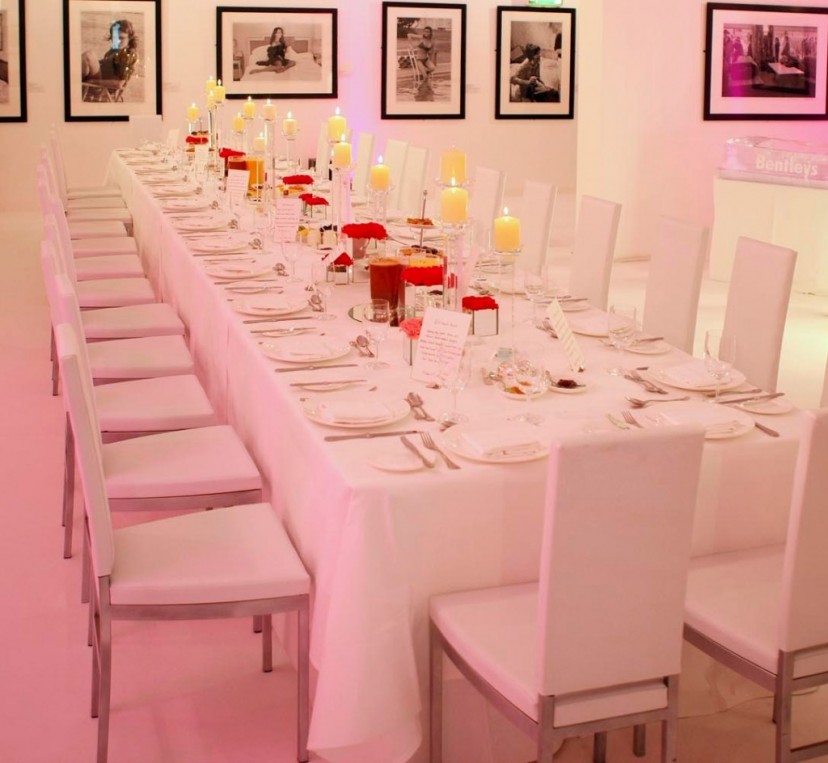Formal Dining - A Guide from Caterhire - How to set your dinner table

The formal place setting enhances the elegance of the dinner table.
A formal meal requires attention to the specific rules for setting the table. These rules have evolved over centuries of diplomatic and social practice. The placement of table coverings and tableware creates an atmosphere of celebration and elegance. The standardised positioning of utensils facilitates eating while maintaining polite conversation. Diners do not have to search for the proper tableware because the best utensil or glass for the dish or beverage currently before them is always right at hand.
Table Cloths and Coverings
A formal table may have a tablecloth and a runner that cover the whole table or place mats that allow the table to show if it is attractive or of interest. A pad should be under the tablecloth both to protect the table and to dampen sound from utensils against the table surface. The tablecloth should hang equally on all sides of the table. Pull the chairs away and walk around the table adjusting where necessary. Roll the runner out along the centre of the table and adjust it so its ends are 1/2 inch from the edge of the table. If using place mats they should also be 1/2 inch from the table’s edge directly in front of the chairs, which should be evenly spaced around the table. Place a cover plate in front of each chair. The edge of the cover plate should be 1 inch from the edge of the table.
Forks, Knives and Spoons
The forks are on the left of the plate, the knives and spoons are on the right. Working outward from the inside by the plate, the dinner fork is first, and then the fish fork. If the salad is served before the fish, then the forks would be arranged (right to left): dinner fork, fish fork, salad fork. On the right working outward from the inside by the plate are the knives with their cutting edge facing inward toward the plate. The knives are arranged (left to right): dinner knife, fish knife, salad knife. The spoons are next out from the plate to the right of the knives, soup spoon first then the fruit spoon. If shellfish are to be served, the oyster fork is placed to the right of the spoons and is the only fork ever placed to the right of the plate. The small butter knife (spreader) is placed diagonally on top of the butter plate, with the handle pointing to the right and the blade down toward the forks. The dessert fork and spoon are usually brought in when the dessert is served.
Glasses, Cups and Napkins
There may be as many as five glasses and they are placed above the knives and spoons so that the smaller ones are on the right. The water goblet is placed directly above the knives. Then to the right of that go a champagne flute, a red or white wine glass and a sherry glass. Coffee cup and saucer are placed to the right of knives and spoons. The napkin is placed on top of the charger if there is one, or in the space for the plate.
Plates
The placement of plates and all tableware is governed by the menu that is being served. A representative menu would include and appetizer such as shellfish, the first course such as soup or fruit, a fish course, the entree or main course and the salad. The salad may be served either with or after the entree. The service plate or charger is the under plate for several courses that precede the entree. The entree will have its own under plate. The butter plate is small and is placed above the forks at the left of the place setting.
Centrepieces, Candles and Salt
The flower arrangements or other centrepiece items should never be above eye level. Position the candle holders so that diners can make eye contact across the table. Individual salt and pepper shakers go above the main course fork at each place. Shared shakers go between the chargers.
From our Blog
-
Game On! Top Garden Games to Hire for Events
If you’re planning a party, wedding, communion or anything in between and want to entertain both ch …17th Apr 2024 -
What Size Tables Do I Need for my Event? Table Sizes and Seating Guide
When you’re setting up your dining area for any type of event, it’s vital to be aware of the approp …12th Apr 2024 -
Caterhire's Essential Guide to Glassware Hire for Events
Introducing the Essential Guide to Glassware for Events! We at Caterhire.ie are experts in Glasswar …26th Mar 2024



